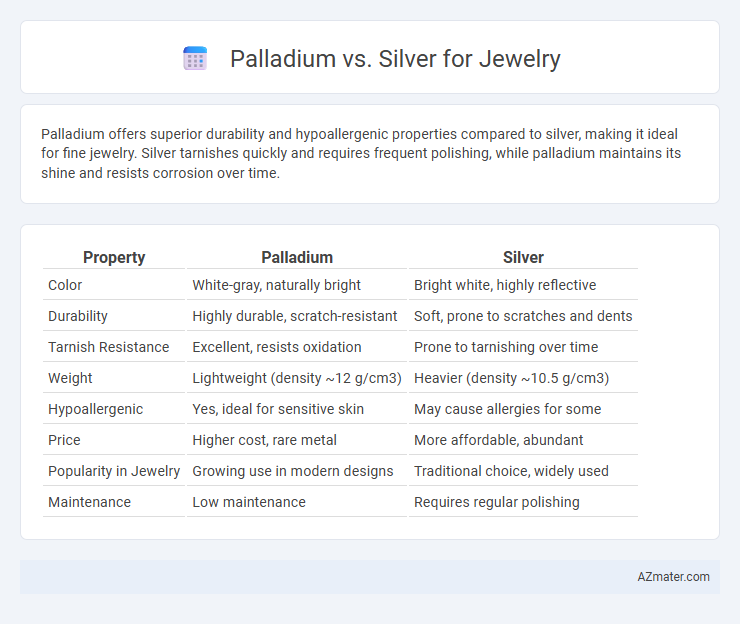Palladium offers superior durability and hypoallergenic properties compared to silver, making it ideal for fine jewelry. Silver tarnishes quickly and requires frequent polishing, while palladium maintains its shine and resists corrosion over time.
Table of Comparison
| Property | Palladium | Silver |
|---|---|---|
| Color | White-gray, naturally bright | Bright white, highly reflective |
| Durability | Highly durable, scratch-resistant | Soft, prone to scratches and dents |
| Tarnish Resistance | Excellent, resists oxidation | Prone to tarnishing over time |
| Weight | Lightweight (density ~12 g/cm3) | Heavier (density ~10.5 g/cm3) |
| Hypoallergenic | Yes, ideal for sensitive skin | May cause allergies for some |
| Price | Higher cost, rare metal | More affordable, abundant |
| Popularity in Jewelry | Growing use in modern designs | Traditional choice, widely used |
| Maintenance | Low maintenance | Requires regular polishing |
Introduction to Palladium and Silver in Jewelry
Palladium and silver are both popular metals used in jewelry, valued for their unique qualities and aesthetics. Palladium, a rare white metal in the platinum family, is known for its durability, hypoallergenic properties, and naturally white luster that resists tarnish. Silver, primarily composed of sterling silver (92.5% pure silver), is prized for its affordability, bright shine, and malleability but requires regular care to prevent oxidation and tarnishing.
Physical Properties Comparison
Palladium is a dense metal with a specific gravity of 12.0, making it heavier than silver, which has a specific gravity of 10.49. Palladium offers superior corrosion resistance and does not tarnish easily, maintaining its luster over time, whereas silver is prone to tarnishing due to sulfur reactions. The hardness of palladium, typically around 4.75 on the Mohs scale, surpasses silver's 2.5 to 3, providing better scratch resistance for long-lasting jewelry wear.
Appearance and Aesthetic Appeal
Palladium offers a naturally white, lustrous finish that retains its bright sheen without tarnishing, making it ideal for jewelry that demands long-lasting brilliance. Silver provides a shiny, reflective surface with a classic, warm tone but requires frequent polishing due to its tendency to tarnish over time. Both metals suit different aesthetic preferences: palladium delivers a modern, subtle elegance, while silver maintains a traditional, radiant charm.
Durability and Hardness
Palladium offers superior durability and hardness compared to silver, making it more resistant to scratches and dents in jewelry. While silver is softer with a Mohs hardness of around 2.5 to 3, palladium rates approximately 4.75 on the Mohs scale, providing longer-lasting wear. This enhanced resilience makes palladium an excellent choice for jewelry pieces requiring sustained strength and minimal maintenance.
Hypoallergenic Qualities
Palladium is highly valued in jewelry for its hypoallergenic properties, making it an excellent choice for individuals with sensitive skin or metal allergies. Unlike silver, which can sometimes cause allergic reactions due to trace amounts of nickel or other alloys, palladium is naturally nickel-free and resistant to tarnish. This durability and purity ensure that palladium jewelry maintains its hypoallergenic integrity over time, offering a safe and long-lasting option for sensitive wearers.
Price and Investment Value
Palladium jewelry commands a higher price than silver due to its rarity and durability, making it a more valuable investment option. Silver remains affordable and accessible, though it is more prone to tarnish and wear, reducing long-term investment potential. Investors typically prefer palladium for its market stability and demand in automotive and industrial sectors, which support sustained value growth.
Maintenance and Tarnish Resistance
Palladium jewelry offers superior tarnish resistance compared to silver, requiring minimal maintenance to retain its bright, white luster over time. Silver is prone to oxidization, leading to frequent tarnish that necessitates regular cleaning with polishing cloths or silver dips. The low reactivity of palladium makes it an ideal choice for long-lasting, low-maintenance jewelry that maintains its appearance with little effort.
Popular Jewelry Applications
Palladium is favored in jewelry for its naturally white luster, resistance to tarnish, and hypoallergenic properties, making it ideal for engagement rings and wedding bands. Silver, known for its affordability and bright shine, is popular in fashion jewelry and intricate designs but requires regular maintenance due to tarnishing. Both metals serve distinct market niches, with palladium appealing to luxury buyers seeking durability and silver attracting those prioritizing cost and versatility.
Environmental Impact and Sourcing
Palladium mining generally has a lower environmental footprint than silver due to smaller-scale extraction and higher recycling rates, reducing habitat disruption and energy consumption. Silver mining often involves toxic chemicals like cyanide and mercury, leading to soil and water contamination, making sourcing more environmentally challenging. Ethically sourced palladium from certified responsible mines supports sustainable practices, while silver's broader availability increases the risk of less regulated extraction methods.
Choosing Between Palladium and Silver
Choosing between palladium and silver for jewelry depends on factors like durability, hypoallergenic properties, and price. Palladium offers superior tarnish resistance and a naturally white sheen, making it ideal for those seeking low-maintenance pieces, while silver provides a more affordable option with a classic look but requires regular polishing to prevent oxidation. Jewelers often recommend palladium for engagement rings due to its strength and hypoallergenic benefits, whereas silver remains popular for fashion jewelry and budget-conscious buyers.

Infographic: Palladium vs Silver for Jewelry
 azmater.com
azmater.com